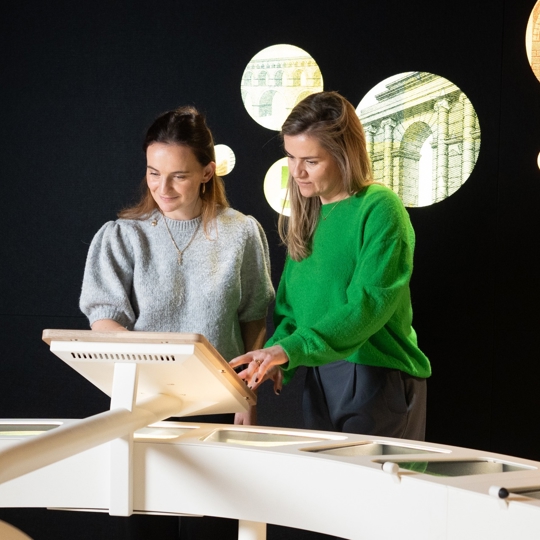Education
Learn all about the economy


A frayed old briefcase contains over five hundred thousand-mark notes from 1923. It wouldn't even buy you a kilo of bread back then.
Surely you have noticed that your coffee to go is getting more and more expensive. Prices are rising fast due to extreme drought and heat in Brazil and other coffee producing countries, among other reasons. Inflation hits everyone's wallet. That hurts. But it could be a lot worse...
A special object from the National Numismatic Collection shows that times were a lot harder once. In the depot, we discovered a frayed briefcase no one had cared to look at for many years. We could open it only with great difficulty. In the briefcase, we found more than five hundred billion German marks in banknotes. There were also several cheques from the year 1923, including one for one million marks, made out to two Dutch residents: Theo and Catharina. That's all you need to arouse your curiosity.
Unfortunately, our collection records contained no information about the briefcase. However, there was a note hidden in the briefcase with the name and email address of the donor. We tried to get in touch and to our surprise, we soon received a very enthusiastic response. The donor explained that the briefcase did not come from her own relatives, but from a friend's relatives. Her friend was the daughter of the half-brother of Theo, the beneficiary of the cheques. The donor knew nothing more about the story behind the briefcase, but being a historian, she shared our curiosity.

© De Nationale Numismatische Collectie, De Nederlandsche Bank
The briefcase itself does not tell us a lot. So we can only guess what exactly happened to it. We suspect Theo had been to Germany with this briefcase. This is plausible because of the cheques made out to him, in combination with the German banknotes. A cheque from Dresdner Bank made out to Catharina suggests that she travelled with him. But why were they in Germany? That question is difficult to answer.
We know Theo was a bookkeeper at the municipal gas and electricity factory in The Hague. He married Catharina in 1901 and they had no children. Catharina was the daughter of a tobacco retailer. All that can be found of her in the archive are a number of notarised deeds, including one of a loan of 2,100 guilders to a family that ran a mineral water firm in the Netherlands. The firm sold mineral water from Germany and went bankrupt in 1907. Were Theo and Catharina somehow involved in this firm? Did they have shares or did Theo perhaps keep the firm’s books? Could that explain a trip to Germany? It's all just a little too hypothetical. As far as can be ascertained from the archives, neither Theo nor Catherine were from a trading family or a family with connections in Germany.
Of the examples of inflation in world history, the hyperinflation of the 1920s in Germany, known then as the Weimar Republic, is perhaps best known. This inflation was caused by Germany having to make reparation payments to the Allies after World War I. Additional banknotes were printed to meet payment obligations, leading to inflation. Due to inflation, reparations had to be stopped, upon which French and Belgian troops occupied Germany’s industrial region. Meanwhile, the government continued printing banknotes to make up[NC1] for shortages of cash. A vicious circle was created in which money was printed to keep up with inflation, which in turn caused further devaluation, due to which even more money had to be printed.
At the time Theo was presumably in Germany, in the second half of 1923, hyperinflation was at its peak. According to some stories, you had to pay twenty thousand marks to get a cup of coffee in Berlin. But by the time you finished that cup, the value of the mark had fallen, so you had to pay fifty thousand marks for the next cup. That must have been a terrifying sensation.

© De Nationale Numismatische Collectie, De Nederlandsche Bank
Inside the briefcase are more than five hundred thousand-mark notes, tied together in bundles. When Theo left for Germany, let's say in June 1923, he probably figured he would be fine with a whole briefcase full of thousand-mark notes. But by the end of 1923, five hundred thousand marks was not enough to buy even a simple meal. He had to start using notes of 10 million marks, 100 million marks, 1 billion marks, 100 billion marks... Even that was no longer enough at one point. In the end, he had more than five hundred billion marks in his briefcase. As shown on the token below, a pound of bread cost a whopping 260 billion marks on 1 December 1923. This means that, at the time, Theo could not even buy a kilo of bread with all the money in his briefcase. A week later, bread could cost billions more. Five hundred billion marks were merely small change, and big briefcases like this one were used as wallets.

© Bundesarchiv, Georg Pahl
Hyperinflation represented a tragedy for the young Weimar Republic. Banknotes were worth so little that they were even burned in the stove because they were cheaper than fuel. People saw their savings become worthless overnight. Among other things, the misery and unrest provided a breeding ground in which National Socialism could rise, with all its dire consequences.


Unfortunately, no one can tell us the exact story behind the briefcase. All we can do is consider it as a time capsule from an interesting but turbulent period in history. It is objects like these that make the history of our money tangible. Maybe one day we can solve the next piece of the puzzle. In the meantime, the briefcase will be moved to our new depot at Frederiksplein.